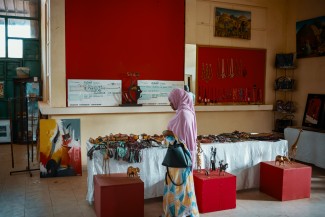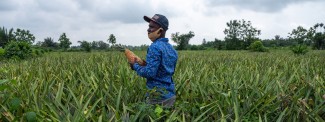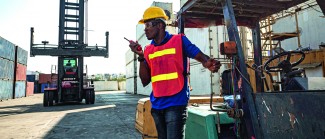The world is changing, and so should our support to the world’s poorest countries
Good policy making requires reacting to facts. When the facts change, so too does policy. Or at least that’s what we’d like to think.
Over the last few decades, we have witnessed the world of global trade and investment become so deeply intertwined that our understandings and frameworks of analyses have also profoundly altered. However, to some extent these changes stand in contrast to the tools we use to support the poorest and most economically vulnerable countries in the world.
There have been calls for greater recognition of the serious and increasing environmental vulnerabilities faced by some of the least developed countries (LDCs). This is especially true for Small Island Developing States (SIDS) whose whole way of life and livelihoods are imminently threatened by climate change. However, a recent recommendation by the Committee for Development Policy (UN CDP) for the creation of a category of countries facing extreme vulnerability to climate change and other environmental shocks was dismissed by UN members in 2018 – a major blow to LDC SIDS. This came following the last triennial review undertaken to identify those LDCs in a position to exit the category; whilst the UN CDP acknowledged that some LDCs may be ready to exit the category based on existing criteria, they noted that “Kiribati and other extremely vulnerable countries should receive support targeting their specific vulnerabilities to climate change and other environmental shocks”.
Now that COVID-19 has exposed the inherent vulnerabilities within an interconnected globalised world – jeopardising the smooth trajectory of the handful of forthcoming graduates from the LDC category – surely greater acknowledgment of the devasting risks arising from environmental vulnerabilities must be forthcoming.
It is disappointing that this support has not been forthcoming.
Now that COVID-19 has exposed the inherent vulnerabilities within an interconnected globalised world – jeopardising the smooth trajectory of the handful of forthcoming graduates from the LDC category – surely greater acknowledgment of the devasting risks arising from environmental vulnerabilities must be forthcoming.
The potential exit of 12 countries from the LDC category – mainly based on income grounds – over the coming few years was never going to be a major celebration for the international development community. There are too many unanswered questions, including why have only five countries in the last 50 years left the category?
The framework used to categorise LDCs itself has some issues, including the ability to compare progress over time. Changes made to the criteria used to identify LDCs have been somewhat arbitrary, for example, regarding the inclusion and then exclusion of population thresholds.
There are also some major assumptions. For example, LDCs with per capita incomes substantially above specific thresholds (US$2,460 in 2018) are deemed to have sufficient resources without recourse to LDC-specific support measures. But, whilst some LDCs do have comparably high per capita incomes relative to the average for all LDCs, their levels of economic and environmental vulnerability are much higher; this includes some of the LDCs posited to graduate soon like the Solomon Islands and Vanuatu (recently affected by Tropical Cyclone Harold, in addition to the economic repercussions of COVID-19).
Even without the global pandemic and the climate emergency we currently face, there were always risks for LDCs previously projected to move out of the category over the coming years. Some of these challenges, such as those related to how LDCs trade within global value chains (GVCs), have been viscerally exposed. Some of the poorest countries in the world such as Bangladesh and Cambodia have been battling, within the midst of the coronavirus pandemic, against multinational firms to secure payment for goods contracted for and already in transit.
Smaller, poorer and economically vulnerable countries simply do not have the economic clout to enhance the type of resilience being advocated for in the developed world. They rely on the framework of rules construed under the spirit of multilateralism to anchor their trade and development aspirations.
The extremely limited nature of export (as well as import) diversification and insertion within what can only be described as captive GVCs, coupled with the fact that the international support architecture as currently construed fails to tackle these issues, would always have meant that exit from the LDC category could be a bumpy road. As the COVID-19 pandemic struck, trading relationships within GVCs have been broken, and globally trade barriers have been put up, not down. This does not bode well in view of future global shocks ensuing from climate change.
Smaller, poorer and economically vulnerable countries simply do not have the economic clout to enhance the type of resilience being advocated for in the developed world. They rely on the framework of rules construed under the spirit of multilateralism to anchor their trade and development aspirations. The LDC category has helped to provide such an anchor; it has secured particular benefits under the WTO’s enabling clause since its creation. But these benefits have been severely eroded over time and now globalisation is in retreat. Whilst more focused discussion on differentiation issues had begun at the WTO prior to the pandemic, including how to graduate, looking ahead to 2020-2030, the international support architecture for LDCs must be updated to the current reality faced.
For countries identified as being ready to graduate but reluctant to do so (such as Kiribati and Tuvalu), the current crisis validates some of their major concerns: such as the inability to secure support outside of the category in the midst of a severe shock (economic or environmental). For example, whilst the G20 Trade and Investment Ministerial Statement specifically refers to support to LDCs, it doesn’t make reference to other structural characteristics that would warrant greater support by the international community, like distance to end markets, trade costs and so on. Exiting the category now without transitional support measures guaranteed seems a risk some LDCs may deem too high.
For those countries remaining stubbornly far from the graduation thresholds, we should acknowledge that this is because the support measures conferred fail to effectively target their needs. Most trade preferences do not tackle the issues regarding commodity dependency; there is only so much that current levels of aid for trade alone can do; ODA remains short of levels advocated for. Despite the persistent advocacy by the UN CDP, the LDC category is not recognised by international financial institutions in their lending. Many LDCs, particularly in sub-Saharan Africa, are trapped in a perpetual cycle of boom and bust; without the necessary tools and expertise to effectively manage their own natural resources. Desired market access – such as labour mobility – is increasingly off the table, particularly as the developed world turns inwards.
Both LDCs on the graduation path and those far from it will have experienced formidable setbacks to development trajectories in view of the coronavirus pandemic. COVID-19 has exposed their trade vulnerabilities, and it is imperative that they be made more resilient.
Header image - ©Kailash Kumbhkar from Pixabay; Other images - ©Paolo Cerutti
If you would like to reuse any material published here, please let us know by sending an email to EIF Communications: eifcommunications@wto.org.



